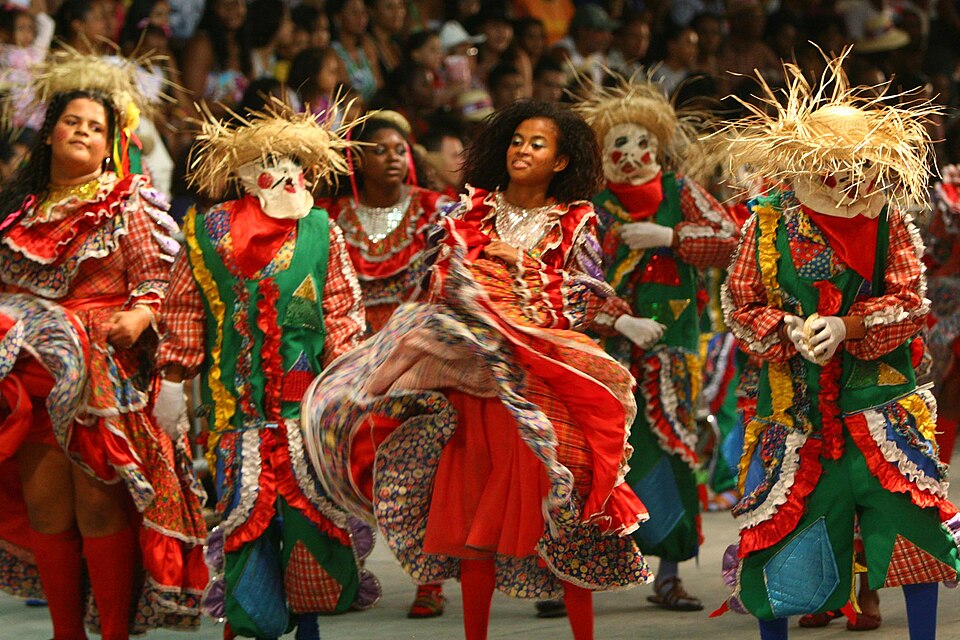Brazil’s Festas Juninas: Joyous Mid-Year Celebrations
Every June, Brazil bursts into color, music, and flavor with the arrival of the Festas Juninas (June Festivals). These are a beloved series of traditional festivals that honor rural life, Catholic saints, and the cultural heritage of the Brazilian interior. The celebrations, deeply rooted in both Portuguese and Indigenous traditions, take place throughout the month of June. The three most important days are Dia de Santo Antônio (June 13), Dia de São João (June 24), and Dia de São Pedro (June 29). Though these festivities are nationwide, they are especially vibrant in the Nordeste (Northeast) region of Brazil, where they often rival Carnival in popularity.
Origins and History of Brazil’s Festas Juninas
The Festas Juninas originated from European midsummer festivals, brought to Brazil by Portuguese colonizers in the 16th century. These festivals were Christianized over time to celebrate saints such as Santo Antônio, São João Batista, and São Pedro. In rural Brazil, where Catholic traditions mixed with Indigenous and Afro-Brazilian elements, the June festivals became an opportunity to celebrate harvests, pray for rain, and engage in community life.
Originally called Festas Joaninas (in honor of Saint John), the name eventually evolved into Festas Juninas to reflect the broader celebration of June saints. Today, they remain a proud expression of Brazil’s agricultural heritage and regional diversity.
Customs and Traditions of Brazil’s Festas Juninas
At the heart of every Festa Junina is the arraial, a community party often held in a decorated square or large open area or tent. These are adorned with colorful bandeirinhas (paper flags), balões (balloon-shaped lanterns), and rustic touches to evoke a country village atmosphere. Attendees often dress in trajes caipiras, rural-style costumes—homens wear patched shirts and straw hats, while mulheres don plaid dresses and pigtails with painted freckles, mimicking traditional caipira (country folk) attire.
A highlight of the festivities is a kind of square dance known as the quadrilha. It’s a lively group folk dance inspired by European court dances but infused with Brazilian flavor. Performed to the sounds of forró, baião, and xote music, the quadrilha features humorous narration and choreography simulating rural life. At the center of the quadrilha is a casamento caipira (mock wedding), and the bride and groom are the focus of the other dancers.
Fogos de artifício (fireworks), fogueiras (bonfires), and playful games like pescaria (fishing game), corrida de saco (sack race), corrida de três pés (three-legged race), jogo de argolas (ring toss), and derruba-lata (can knockdown) add to the joyful atmosphere, especially for children.
Modern Criticism
The depictions of caipiras during Brazil’s Festas Juninas have produced some criticism of certain aspects of the festivals. Celebrants may blur the line between a playful or humorous depiction of country life and mocking stereotypes. This is especially the case with celebrations in large cities, where festivalgoers dressed as caipiras may act like simple and foolish bumpkins. This is a topic for debate. For many Brazilians, this part of the festas is nothing more than humorous and well-intentioned play. For others, it is an elitist caricature that exposes the rift between rural and urban, poor and wealthy.
Food and Drink of Brazil’s Festas Juninas
No Festa Junina would be complete without its rich and comforting comidas típicas (typical dishes). Many of these feature milho (corn), as June is harvest time for this staple. Popular treats include:
- Pamonha – sweet or savory boiled corn paste wrapped in corn husks
- Canjica – a sweet porridge made from white corn, milk, sugar, and cinnamon
- Curau – a creamy corn pudding
- Bolo de milho – corn cake
- Cuscuz nordestino – steamed cornmeal cake, often savory
- Quentão – a warm drink made with cachaça, ginger, cloves, and cinnamon
- Vinho quente – hot spiced wine, more common in the South
These dishes enjoy a deep connection to the rustic spirit of the celebrations. People often share them communally in the arraial.
Regional Variations
While Festas Juninas are celebrated nationwide, they take on unique flavors depending on the region. In the Nordeste, cities like Campina Grande (Paraíba) and Caruaru (Pernambuco) compete for the title of the maior São João do mundo—the world’s largest Saint John festival. These cities host massive arraiais with live music, dance contests, and cultural showcases attracting millions of visitors.
In contrast, in the South and Southeast, such as in São Paulo and Minas Gerais, the festivals are often organized by schools, churches, and local communities, retaining a more intimate and familial feel.
Modern Significance
Today, Brazil’s Festas Juninas are more than just religious observances. For many, they are a celebration of Brazilian identity, especially of its rural roots. They offer a nostalgic counterbalance to urban life, allowing city dwellers to reconnect with the traditions of the interior. For others, some aspects of the festas highlight the great divides in Brazilian society. But even with their thorny issues, the festas are a treasured part of the calendar. They evoke memories of childhood, community, and cultural pride. Viva São João! Vivam as festas juninas!
Get on the road to speaking Portuguese with the Language Garage!
We hope you’ve enjoyed learning about Brazil’s Festas Juninas. If you’d like to learn more:
- Follow us on Facebook, LinkedIn, BlueSky, Twitter, Threads, Mastodon, Instagram, or Pinterest. We publish lots of Portuguese vocabulary, grammar, and culture notes, so it’s a great way to pick up some new vocabulary and practice.
- Check out our other posts on Portuguese language, culture, and more.
- Enroll in affordable, flexible, and personalized private online Portuguese lessons or sign up for a small group online Portuguese class.
- Create a free Language Garage account to access tons of Portuguese vocabulary, grammar, and culture.
Image Source Wikimedia Commons






